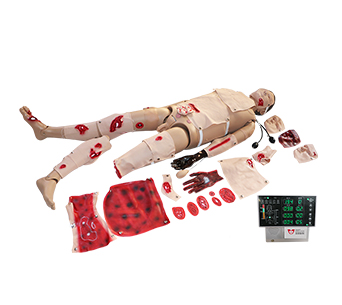■ This simulator is widely used in various departments such as military,
fire, police, aviation, coal mines, construction, etc., fire,
mountains, high altitude, oil pipes industry, tunnels, collapsed
buildings, ruins, explosions and other emergency scenes
■ The joints
of the simulator are very flexible, the head can be rotated 180 degrees
horizontally, and various poses can be simulated in the emergency scene
■
The surface of the simulator has obvious signs, including sternal
notch, sternum, ribs, etc., which is convenient for operation and
positioning
■ Each trauma component can be flexibly fixed on the
"wounded" body, and can create a real bleeding environment, and the
blood flow can be adjusted
■ Pupil teaching: normal pupil on one side, dilated pupil on the other side
■ Nasogastric feeding: the simulated gastric juice can be drawn out if the operation is correct
■ Can check carotid pulse
■ The chest is elastic, and the lung ventilation can be ups and downs
■
You can practice CPR mouth-to-mouth artificial respiration: pinch the
nose of the simulator with the thumb and index finger of one hand, lift
the jaw with the other hand, tilt the head back, and blow with the lips
around the mouth, each time for more than 1 second. Pay attention to the
rise and fall of the chest. Cardiac compression: The compression site
is the middle of the sternum of the two fingers on the substernal notch
of the chest or the level of the nipple connecting the middle of the
chest, and the compression frequency is more than 100 times/minute
■ Intramuscular injection: vastus lateralis muscle, upper arm intramuscular injection
■ There are indicator lights on the electronic display to show consciousness judgment, pulse check, check breathing, emergency call, and remove foreign objects.
■ The standard rate of pressing and blowing can be set.
■ Operation mode (training, assessment, competition), each mode can be set by yourself, flexible and convenient
* Training mode: You can perform pressing and blowing exercises, you can set the training time, and monitor various parameters of pressing in real time: pressing position, depth, frequency, and detect the blowing time and tidal volume at the same time. When it is not within the standard range, there is a voice prompt ( Too large, too small, gas into the stomach, compression position, compression not rebound).
* Assessment mode: In line with AHA operation procedures: judging environmental safety, slapping, calling, judging breathing and carotid arteries, calling for help, opening airway, removing oral foreign bodies and other operations.
■ After the operation, the results can be printed. The contents of the transcript are complete, and multiple indicators can be displayed: pressing depth, pressing frequency, pressing position, insufflation volume, insufflation time, judging environmental safety, slapping, calling, judging breathing and carotid artery , call for help, open the airway, remove oral foreign bodies, etc.
■ In the competition mode, the operation process can be stored and played back 30 times.
■
Can practice common techniques in emergency scene such as hemostasis,
cleaning, disinfection, dressing, fixation and handling. Trauma
components include:
* Forehead laceration (one bleeding wound)
* Jaw injury (one bleeding wound)
* Chest sucking wound (one bleeding wound)
* Abdominal trauma with small bowel herniation (one bleeding wound)
* Gunshot wound to the palm (one bleeding wound)
* Compound fractures: open fractures of the humerus and forearm (one bleeding wound)
* Compound fractures: open fractures of tibia and calf (one bleeding wound)
* Amputation of the right leg (two bleeding wounds)
* Shock face (a)
* Ⅰ, Ⅱ, Ⅲ degree facial burns (one)
* Modules of lacerations and open fractures of different degrees (twenty-four)"









